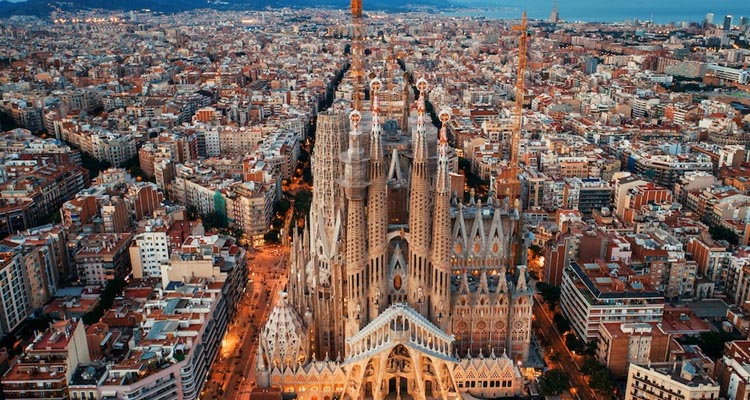Spain in 2025: A Tapestry of Culture, History, and Innovation
Related Articles: Spain in 2025: A Tapestry of Culture, History, and Innovation
Introduction
With great pleasure, we will explore the intriguing topic related to Spain in 2025: A Tapestry of Culture, History, and Innovation. Let’s weave interesting information and offer fresh perspectives to the readers.
Table of Content
Spain in 2025: A Tapestry of Culture, History, and Innovation

Spain, a land steeped in history and vibrant culture, continues to evolve, offering a dynamic and captivating experience for travelers in 2025. The country’s commitment to sustainability, technological advancement, and cultural preservation creates a unique blend of tradition and modernity, making it an ideal destination for those seeking enriching and unforgettable journeys.
A Tapestry of Cultural Experiences
Spain’s cultural tapestry is woven from centuries of history, art, and tradition. From the ancient Roman ruins of Mérida to the Moorish architectural marvels of Granada’s Alhambra, the country boasts a wealth of historical sites that transport visitors back in time.
The vibrant cities of Madrid and Barcelona pulsate with contemporary art, music, and fashion. Madrid’s world-renowned museums, such as the Prado and the Reina Sofía, showcase masterpieces of Spanish art, while Barcelona’s innovative architecture and bustling street art scene reflect its forward-thinking spirit.
Beyond the major cities, Spain’s diverse regions offer a fascinating glimpse into local traditions. The Basque Country, with its unique language and culinary heritage, offers a distinct cultural experience. Andalusia, the southern region, is renowned for its flamenco performances, vibrant festivals, and the Moorish influence that pervades its architecture and lifestyle.
Sustainability and Innovation: Shaping the Future
Spain is actively embracing sustainable practices and technological innovation, shaping a future where eco-consciousness and progress go hand in hand.
The country’s commitment to renewable energy is evident in its vast solar and wind farms, reducing its carbon footprint and contributing to a greener future. This commitment extends to its cities, where sustainable transportation options, like electric buses and bike-sharing programs, are becoming increasingly popular.
Spain is also at the forefront of technological advancements, particularly in areas like artificial intelligence, robotics, and biotechnology. This innovation is reflected in the country’s burgeoning tech sector, attracting international companies and talent.
A Culinary Journey: From Traditional Tapas to Modern Gastronomy
Spanish cuisine is a delightful fusion of flavors, textures, and traditions. The iconic tapas culture, with its small plates of savory and flavorful dishes, offers a vibrant introduction to the country’s culinary heritage.
From the rich paella of Valencia to the hearty stews of Galicia, Spain’s regional specialties showcase the diversity of its culinary landscape. The country’s renowned chefs are pushing the boundaries of modern gastronomy, incorporating innovative techniques and local ingredients to create truly exceptional dining experiences.
Beyond the Cities: Exploring the Natural Wonders of Spain
Spain’s natural beauty is equally captivating, offering a diverse range of landscapes from rugged mountains to pristine beaches. The Pyrenees Mountains, bordering France, offer breathtaking hiking trails and opportunities for skiing in the winter.
The Picos de Europa National Park in northern Spain boasts stunning limestone peaks, deep gorges, and lush forests. Along the Mediterranean coast, Spain’s picturesque beaches, such as those in Costa Brava and Costa del Sol, provide idyllic settings for relaxation and water sports.
FAQs
Q: What is the best time to visit Spain?
A: The best time to visit Spain depends on your preferences. Spring (April-May) and autumn (September-October) offer pleasant weather, fewer crowds, and vibrant festivals. Summer (June-August) is ideal for beach holidays, but temperatures can be very high.
Q: What are the most popular tourist destinations in Spain?
A: Madrid, Barcelona, Seville, Granada, and Valencia are among the most popular tourist destinations. Each city offers a unique blend of history, culture, and vibrant nightlife.
Q: What are the best ways to get around Spain?
A: Spain has a well-developed transportation network. High-speed trains (AVE) connect major cities, while buses provide more affordable options. Car rentals are available, but traffic can be congested in major cities.
Q: What are some tips for planning a trip to Spain?
A:
- Book flights and accommodation in advance, especially during peak season.
- Learn basic Spanish phrases, which can enhance your travel experience.
- Pack comfortable shoes for walking, as many attractions are spread out.
- Be aware of local customs, such as the siesta (afternoon nap) and the importance of family meals.
- Enjoy the vibrant nightlife, but be mindful of noise levels in residential areas.
Conclusion
Spain in 2025 promises a captivating journey through a land rich in history, culture, and innovation. From the vibrant cities to the stunning natural landscapes, the country offers a diverse range of experiences for all types of travelers. By embracing sustainability and technological advancements, Spain is shaping a future where tradition and progress coexist harmoniously, ensuring a memorable and enriching travel experience for all.








Closure
Thus, we hope this article has provided valuable insights into Spain in 2025: A Tapestry of Culture, History, and Innovation. We hope you find this article informative and beneficial. See you in our next article!